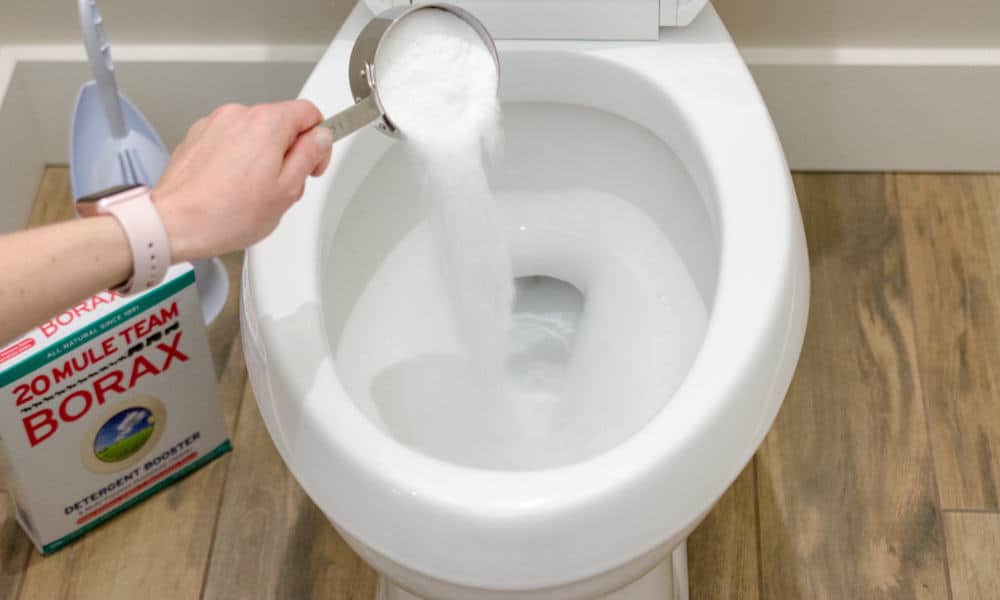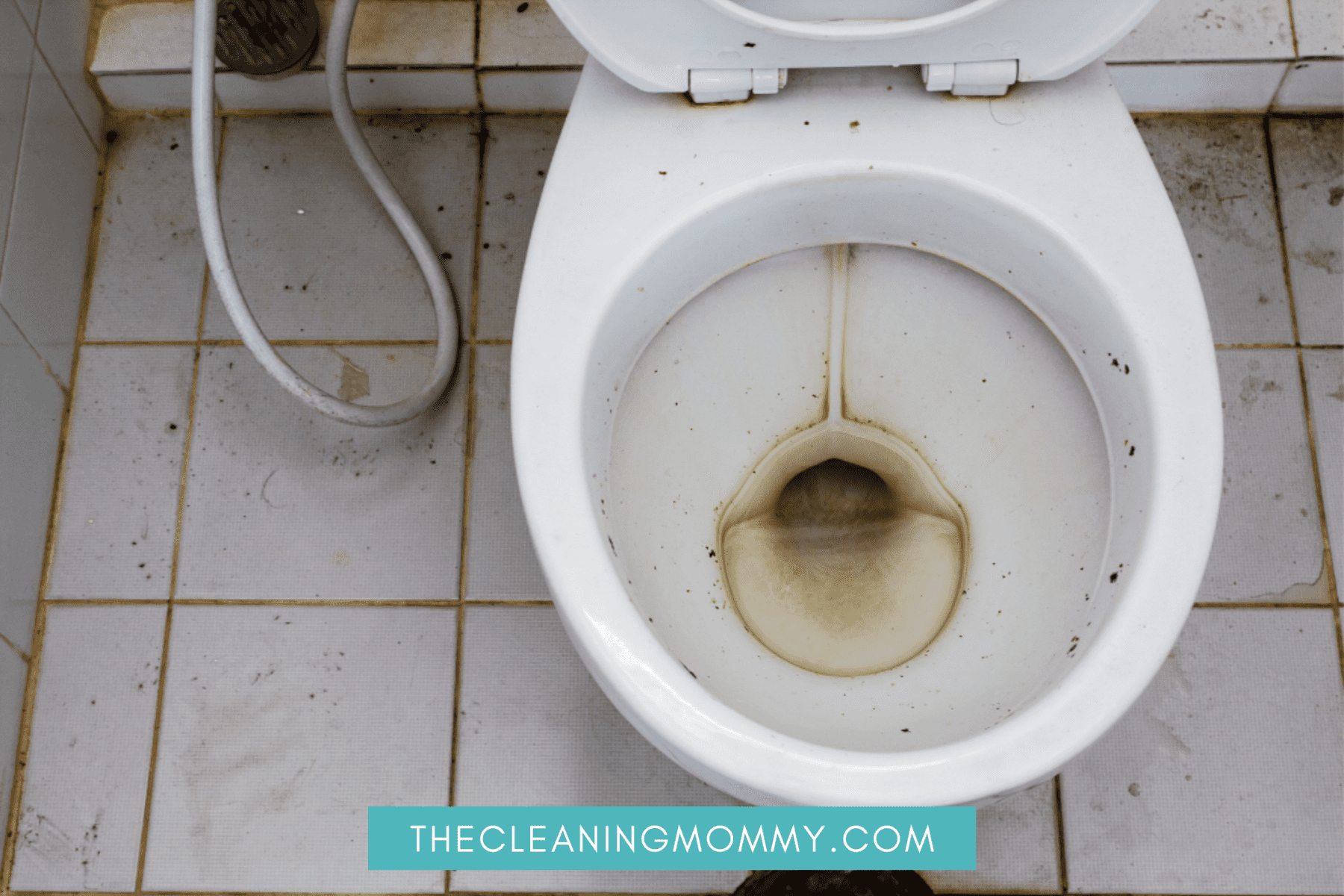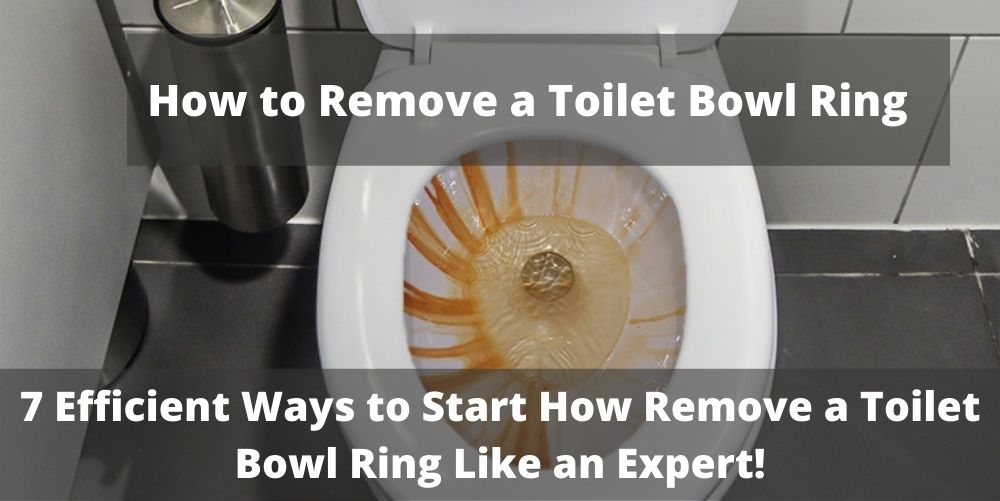How to get rid of brown ring in toilet – Ever noticed that unsightly brown ring lurking at the waterline of your toilet bowl? It’s a common problem that can make even the cleanest bathroom look dingy. The brown ring is often caused by a combination of mineral deposits, hard water, and even bacteria. But fear not, there are several ways to banish this stubborn stain and restore your toilet to its pristine glory.
From simple home remedies to powerful commercial cleaners, we’ll explore a range of options to tackle the brown ring head-on. We’ll also delve into the science behind its formation, helping you understand why it appears and how to prevent it from returning. Whether you’re a seasoned cleaning pro or a novice in the bathroom battles, this guide will equip you with the knowledge and tools to conquer the brown ring and achieve a sparkling toilet.
Understanding the Brown Ring

A brown ring in your toilet bowl is a common sight, often associated with unpleasant odors. It’s a sign of mineral buildup and potential hygiene issues. Understanding the causes and composition of this ring is crucial for effective cleaning and prevention.
Causes of the Brown Ring
The brown ring is typically caused by a combination of factors, including:
- Hard Water: Hard water contains high concentrations of dissolved minerals, primarily calcium and magnesium. These minerals precipitate out of the water, leaving behind a residue that can stain the toilet bowl.
- Iron: Iron is another common mineral found in water. Iron can react with oxygen to form iron oxide, which is the reddish-brown compound responsible for the ring’s color.
- Manganese: Manganese is another mineral that can contribute to the brown ring. It can form black or brown oxides, depending on the oxidation state.
- Urine: Urine contains various organic compounds, including uric acid, which can react with minerals in the water to form a sticky residue. This residue can trap other minerals, leading to the formation of the brown ring.
- Poor Flushing: Inadequate flushing can allow mineral deposits and urine to accumulate in the toilet bowl, contributing to the ring’s formation.
Chemical Reactions Contributing to the Brown Ring
The brown ring is formed through a series of chemical reactions involving the minerals present in water and the organic compounds in urine.
- Calcium Carbonate Formation: Calcium ions (Ca 2+) in hard water react with bicarbonate ions (HCO 3–) to form calcium carbonate (CaCO 3), which is the primary component of limescale. The reaction is represented by the following equation:
Ca2+ + 2HCO 3– → CaCO 3 + CO 2 + H 2O
- Iron Oxide Formation: Iron ions (Fe 2+) in water react with oxygen (O 2) to form iron oxide (Fe 2O 3), which is the reddish-brown compound responsible for the ring’s color. The reaction is represented by the following equation:
4Fe2+ + O 2 + 4H 2O → 2Fe 2O 3 + 8H +
Types of Brown Rings
Brown rings in toilets can vary in composition and appearance. The following are some common types:
- Limescale Ring: This is the most common type of brown ring, primarily composed of calcium carbonate. It is typically white or yellowish but can appear brown due to the presence of other minerals and organic matter.
- Iron Oxide Ring: This ring is characterized by its reddish-brown color and is caused by the presence of iron oxide. It can be quite stubborn and difficult to remove.
- Manganese Oxide Ring: This ring can be black or brown, depending on the oxidation state of manganese. It is often found in areas with high levels of manganese in the water.
- Organic Matter Ring: This ring is caused by the accumulation of organic matter, such as urine and soap residue. It can be sticky and difficult to remove.
Prevention Strategies
Preventing brown rings in your toilet is about proactive maintenance and good hygiene practices. A clean toilet is less likely to develop these unsightly stains. Here are some prevention strategies to keep your toilet sparkling white.
Regular Cleaning and Maintenance
Regular cleaning is crucial in preventing brown rings. A buildup of mineral deposits and organic matter is the primary cause of these stains. Here are some tips for effective toilet cleaning:
- Daily Cleaning: A quick wipe-down of the bowl with toilet paper or a damp cloth after each use can help remove any lingering stains.
- Weekly Cleaning: A thorough cleaning with a toilet bowl cleaner should be done at least once a week. This helps to break down mineral deposits and prevent them from building up.
- Monthly Cleaning: For deeper cleaning, use a toilet bowl cleaner with a bleach-based formula to eliminate any stubborn stains. Remember to always follow the instructions on the cleaner’s label.
- Check for Leaks: A slow leak can contribute to mineral buildup and brown ring formation. Check for leaks regularly and address them promptly.
Using Toilet Bowl Cleaners
Toilet bowl cleaners play a significant role in preventing brown rings. They contain chemicals that break down mineral deposits and prevent them from adhering to the porcelain surface.
- Choose a Powerful Cleaner: Look for a toilet bowl cleaner with a strong formula designed to remove hard water stains and mineral deposits.
- Regular Application: Apply the cleaner regularly, as recommended by the manufacturer. This ensures that the bowl is consistently cleaned and prevents the buildup of mineral deposits.
- Follow Instructions: Always read and follow the instructions on the cleaner’s label. This ensures that the cleaner is used safely and effectively.
Removal Methods
Now that you understand the causes of brown rings and how to prevent them, let’s dive into the practical methods for removing them. There are various approaches you can try, ranging from natural remedies to powerful commercial cleaners.
Comparing Cleaning Methods
Choosing the right method depends on the severity of the ring and your personal preference. Here’s a table comparing some common cleaning methods:
| Method | Pros | Cons |
|---|---|---|
| Baking Soda and Vinegar | Natural, inexpensive, generally safe | May require multiple applications, not effective for severe stains |
| Commercial Toilet Bowl Cleaners | Powerful, fast-acting, often effective for stubborn stains | Can be harsh on porcelain, may contain harmful chemicals |
| Pumice Stone | Physical scrubbing, can remove tough stains | Can scratch porcelain if used incorrectly |
| Lemon Juice | Natural, mild acidity | May not be effective for severe stains |
Using Baking Soda and Vinegar
Baking soda and vinegar create a fizzy reaction that helps to loosen and lift the stain. Here’s how to use this method:
- Pour 1 cup of baking soda into the toilet bowl, focusing on the area with the brown ring.
- Pour 1 cup of white vinegar into the bowl. The mixture will fizz and bubble.
- Let the solution sit for 30 minutes to an hour, allowing the baking soda and vinegar to work their magic.
- Scrub the area with a toilet brush, paying special attention to the brown ring.
- Flush the toilet to rinse away the solution and debris.
- Repeat the process if necessary, as multiple applications may be needed for stubborn stains.
Using Commercial Toilet Bowl Cleaners
Commercial cleaners often contain strong chemicals that can effectively remove stubborn stains. However, it’s essential to use these cleaners cautiously:
- Always read and follow the instructions on the product label.
- Wear protective gloves and ensure adequate ventilation.
- Pour the cleaner directly onto the brown ring, focusing on the affected area.
- Let the cleaner sit for the recommended time, usually 10-15 minutes.
- Scrub the area with a toilet brush, working the cleaner into the stain.
- Flush the toilet to rinse away the cleaner and debris.
- If the ring persists, repeat the process.
Natural Remedies

While commercial cleaners are effective at removing brown rings, some people prefer natural remedies for their eco-friendliness and affordability. Let’s explore some natural options and their effectiveness.
Effectiveness of Natural Remedies
Natural remedies like lemon juice and borax can be effective in removing brown rings, but their effectiveness depends on the severity of the stain and the frequency of application.
- Lemon Juice: Lemon juice is a natural acidic cleaner that can help break down mineral deposits and stains. It’s also a good deodorizer.
- Borax: Borax is a natural mineral that is often used as a cleaning agent. It can help to remove stains and disinfect surfaces.
Using Lemon Juice and Borax
Here are some steps on how to use these natural remedies:
Lemon Juice
- Pour a cup of lemon juice directly into the toilet bowl.
- Let it sit for at least 30 minutes, ideally overnight.
- Scrub the toilet bowl with a toilet brush, focusing on the brown ring.
- Flush the toilet to rinse away the lemon juice.
Borax
- Pour 1/2 cup of borax into the toilet bowl.
- Add 1 cup of hot water.
- Let the mixture sit for at least 30 minutes, ideally overnight.
- Scrub the toilet bowl with a toilet brush, focusing on the brown ring.
- Flush the toilet to rinse away the borax.
Comparing Natural Remedies and Commercial Cleaners, How to get rid of brown ring in toilet
While natural remedies can be effective, they may not be as powerful as commercial cleaners. Commercial cleaners often contain stronger chemicals that can break down stains more quickly. However, natural remedies are generally safer for the environment and for people with sensitive skin.
It’s important to note that the effectiveness of any cleaning method depends on the severity of the stain and the frequency of application.
Hard Water and Brown Rings: How To Get Rid Of Brown Ring In Toilet

Hard water, rich in dissolved minerals like calcium and magnesium, can significantly contribute to the formation of brown rings in your toilet bowl. These minerals, when combined with other substances like iron, can form a stubborn, unsightly stain.
Dealing with Hard Water Stains
Hard water stains can be challenging to remove, but there are effective strategies you can implement. Here are some tips:
- Use a commercial hard water stain remover: These products are specifically formulated to break down mineral deposits and remove hard water stains. Follow the instructions on the product label for best results.
- Apply a paste of baking soda and water: Create a paste with baking soda and water, and apply it to the affected area. Let it sit for a few hours before scrubbing with a toilet brush.
- Use a pumice stone: Gently rub a pumice stone on the stain. Be careful not to scratch the porcelain surface.
- Try a vinegar solution: Pour a cup of white vinegar into the toilet bowl and let it sit for an hour before scrubbing.
Water Softeners and Brown Rings
Water softeners can effectively prevent the formation of brown rings by removing the minerals that cause them. These devices replace calcium and magnesium ions with sodium ions, making the water “softer.” This process reduces the likelihood of mineral deposits forming on your toilet bowl.
- Installation: Water softeners are typically installed on the main water line entering your home. They require regular maintenance, including salt refills, to function effectively.
- Benefits: Besides preventing brown rings, water softeners offer several other benefits, including:
- Improved soap lathering
- Reduced soap scum buildup
- Longer lifespan for appliances
- Softer skin and hair
Armed with the right knowledge and a little elbow grease, you can bid farewell to the brown ring and enjoy a sparkling clean toilet. Remember, regular cleaning and preventative measures are key to keeping your bathroom looking its best. So, roll up your sleeves, grab your cleaning supplies, and say goodbye to that stubborn stain for good!
Answers to Common Questions
What causes the brown ring in the toilet?
The brown ring is typically caused by a combination of mineral deposits, hard water, and bacteria. Mineral deposits, like calcium and magnesium, can build up over time, creating a stain. Hard water can also contribute to the formation of the ring due to its high mineral content. Bacteria can further exacerbate the discoloration.
Is it safe to use bleach to remove the brown ring?
While bleach can be effective in killing bacteria and whitening the toilet bowl, it’s important to use it cautiously. Always follow the manufacturer’s instructions and ensure proper ventilation. Prolonged exposure to bleach can damage the toilet bowl and irritate the skin and respiratory system.
Can I prevent the brown ring from forming?
Yes, you can prevent the brown ring by practicing regular toilet cleaning, using a toilet bowl cleaner with stain-fighting properties, and considering a water softener if you have hard water.